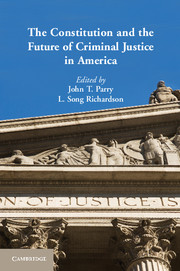Book contents
- Frontmatter
- Contents
- Contributors
- Acknowledgments
- Introduction
- Part I Foundations – The Scope of Criminal Law and Access to Counsel
- Part II Race and Criminal Procedure
- Part III Policing and Privacy
- 5 The Exclusionary Rule
- 6 Consent, Dignity, and the Failure of Scattershot Policing
- 7 Neurotechnologies at the Intersection of Criminal Procedure and Constitutional Law
- Part IV Technology and the Surveillance Society
- Part V Confessions and miranda
- Part VI Conviction, Sentencing, and Incarceration
- Part VII Emergencies and Borders – Immigration, Terrorism, National Security, and Transnational Crime
- Index
- References
7 - Neurotechnologies at the Intersection of Criminal Procedure and Constitutional Law
Published online by Cambridge University Press: 05 June 2014
- Frontmatter
- Contents
- Contributors
- Acknowledgments
- Introduction
- Part I Foundations – The Scope of Criminal Law and Access to Counsel
- Part II Race and Criminal Procedure
- Part III Policing and Privacy
- 5 The Exclusionary Rule
- 6 Consent, Dignity, and the Failure of Scattershot Policing
- 7 Neurotechnologies at the Intersection of Criminal Procedure and Constitutional Law
- Part IV Technology and the Surveillance Society
- Part V Confessions and miranda
- Part VI Conviction, Sentencing, and Incarceration
- Part VII Emergencies and Borders – Immigration, Terrorism, National Security, and Transnational Crime
- Index
- References
Summary
The last realm of privacy is your mind. This will invade that.
– CEO of Veritas Scientific Corporation, describing his company’s mind-reading helmet.Introduction
The rapid development of neurotechnologies poses novel constitutional issues for criminal procedure, among other areas of law. These technologies can identify directly from brain waves whether a person is familiar with a stimulus such as a face or a weapon, can model blood flow in the brain to indicate whether a person is lying, and can even interfere with brain processes themselves via high-powered magnets to cause a person to be less likely to lie to an investigator. By obtaining information directly from a subject’s involuntary physiological responses, investigators could use such “neuroassay” technologies to make an end run around the Fifth Amendment privilege against compelled, self-incriminating speech. Neuroassays complicate, as well, the question of what constitutes a Fourth Amendment “search” and “seizure.” Yet, jurisprudence under both amendments stumbles on a conceptually limited distinction between body and mind, physical and informational. Such a distinction can no longer stand, as brain processes and emanations sit at the juncture of these categories.
This chapter first explains why neurotechnologies may be useful in criminal investigations and describes key neurotechnologies actually in use or under development. It then analyzes the implications of these technologies under the Fourth and Fifth Amendments. Building on work by other law and neuroscience scholars, it offers a framework for Fourth and Fifth Amendment analysis that aims to avoid current doctrine’s false dualism.
- Type
- Chapter
- Information
- The Constitution and the Future of Criminal Justice in America , pp. 109 - 134Publisher: Cambridge University PressPrint publication year: 2013
References
- 2
- Cited by

